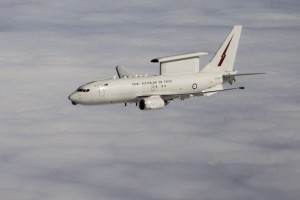2015-01-29 The Wedgetail Command and Control platform and the KC-30A MRTT aircraft are the two new Australian systems operating in Iraq which have been part of the RAAF transformation.
And the Wedgetail squadron is leveraging the operational experience to expand its operational envelope.
Royal Australian Air Force E-7A Wedgetail Airborne Early Warning and Control aircraft recently made history for the longest Australian command and control mission in a war zone during a combat mission over Iraq.
At 16 hours and 18 minutes, the E-7A Wedgetail’s mission entailed the command and control of large numbers of Coalition aircraft operating in Iraqi airspace as part of the multi-national air campaign confronting ISIL.
Commander of Australia’s Air Task Group, Air Commodore Steve Roberton commented on what the endurance mission meant for Australia’s air power capability.
“After already being ‘on station’ for a number of hours, the Australian Wedgetail crew was advised the Coalition aircraft due to relieve them was delayed,” Air Commodore Roberton said.
In response, the Wedgetail crew quickly assessed their ability to coordinate additional air-to-air refueling and agreed to substantially extend their mission.
“Try to imagine coordinating a short-notice, mid-air refuel for a Boeing 737 in the middle of a combat zone. It is no small task,” he said.
Air Commodore Roberton noted Australia’s ability to ‘go above and beyond’ is a clear demonstration of the nation’s important contribution to the Coalition air campaign.

The E-7A Wedgetail crew completed two air-to-air refuels during this mission, allowing it to stay airborne and make the historic time.
The crew first deployed to the Middle East in September 2014 and were regularly undertaking lengthy missions of approximately 13 hours. Including planning and debriefing, the extension to over 16 hours airborne resulted in the aircrew working toward their duty limits.
“The Australian crew’s responsiveness and flexibility made up for a shortfall that night” Air Commodore Roberton said.
Commander of the E-7A Wedgetail Task Element Wing Commander Christian Martin echoed this praise but acknowledged there were also many in Australia who shared in this achievement.
“The performance and reliability of the aircraft are a direct result of the dedication of a joint ‘Wedgetail team’ comprising our Wing Headquarters back home, the Airborne Early Warning and Control Special Projects Office and Boeing Defence Australia,” Wing Commander Martin said.
Wing Commander Martin believes the E-7A Wedgetail has developed into a world-class command and control platform and is the envy of many nations.
(January 13, 2015)
http://www.airforce.gov.au/News/Wedgetail-Endurance-Mission/?RAAF-rfHiMv85HKMNiMHU1ugcodFNsjLFCV3D
For our visit to the Wedgetail Squadron in Australia see the following:
https://sldinfo.com/visiting-the-wedgetail-squadron-at-williamtown-raaf-base-australia/
The video above shows the Wedgetail operating in the Iraq AOR.
2015-01-12 For the first time, the new Australian airborne early warning and C2 aircraft is operating in combat.
Australia’s Air Task Group (ATG) consisting of six RAAF F/A-18F Super Hornets, an E-7A Wedgetail Airborne Early Warning and Control aircraft and a KC-30A Multi-Role Tanker Transport aircraft continue to support Operation OKRA with missions in Iraq.
The ATG comprises nearly 400 RAAF personnel who have deployed to the Middle East. Australia’s efforts are in response to a request for assistance by the Iraqi Government in combating ISIL terrorists.
Operation OKRA is the Australian Defence Force’s contribution to the international effort to combat the ISIL terrorist threat in Iraq. Australia’s contribution is being closely coordinated with the Iraqi government, Gulf nations and a broad coalition of international partners.

